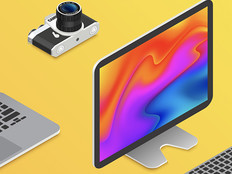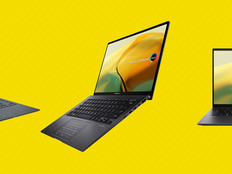Tips to Trick Out Your Mac
Apple has always been a company that thinks outside the box. With the Mac’s good looks, a great operating system and more applications then ever before, more and more users are taking a bite of the Apple.
Even though I’m a die-hard Apple fan, there is always room to customize the Mac to make it even better. Aside from the obvious “add more memory” upgrade, here are a few more ways to make any organization’s Apples even sweeter.
Think Outside the Box
OK, so Macs aren’t boxlike, but cracking one open isn’t as easy as it sometimes is for a PC. That said, if you need extra storage space on your Mac, an external hard drive is a good way to go. But what about speed, you ask? Sure, older Integrated Drive Electronics/AT Attachment (IDE/ATA) internal interfaces offered faster data transfer rates than those external Iomega drives of yesteryear. But older IDE interfaces are simply an extension of the archaic Industry Standard Architecture bus system. Today’s external drives such as the Iomega UltraMax Desktop Hard Drive offer mega capacity (650 gigabytes) but use triple interface connectivity for speed and flexibility. It offers USB 2.0 (about 458 megabits per second), Firewire 400 (400Mbps), or my favorite, Firewire 800 (800Mbps), which is hands down the preferred connection. Simply put, Firewire 800 reduces delays in arbitration and signal distortion while increasing throughput to more than two times the usable (key word here) bandwidth of USB 2.0, making it the perfect choice for high-speed external storage for your Mac.
Don’t Type, Scan It
Each year, optical character recognition technology helps free up huge volumes of storage space that was once relegated to bulging file cabinets or some other physical storage device. OCR technology is one of the fastest and most convenient ways for making lengthy documents quickly available to users. There are two components needed to use OCR: an optical scanner and OCR software such as Readiris Pro 11, which is compatible with the most commonly used images, plus it offers great layout retention and large volume recognition.
If you tried OCR a few years back and quickly became discouraged, I have some good news. Today’s OCR engines use advanced algorithms to analyze the stroke edge (the line of discontinuity between the text characters and the background) making for highly accurate scans. This product supports all TWAIN compliant devices and all TIFF and JPEG formats. The Mac version supports both PowerPC and Intel-based Macs. There is one important caveat: Only a few Intel-based TWAIN scanner drivers are available. However, you may still use your existing scanner because Readiris can run transparently using Rosetta emulation — which dynamically translates most of your PowerPC-based applications to work with your Intel-based Mac — when an Intel-based driver is not available.
The Need for Speed
You don’t need to throw out that old G3- or G4-based Mac to take advantage of the great features of Mac OS X. A processor upgrade can bring an aging Power Mac G3 or G4 up to a respectable 1.5 gigahertz. Unfortunately, however, it cannot help other restrictions on old Macs, such as a slow or limited hard drive, or inadequate amount of random access memory. Because they come with detailed installation instructions, today’s CPU upgrade cards are easy to install but may require that your computer’s firmware be updated to take advantage of added features. That said, with its faster core speed and larger Level 2 cache memory, this type of upgrade can breathe new life into an older Mac, especially when combined with an increase in RAM.
RAID Your System
Today’s business is transacted primarily (and relies heavily) within a complex integrated global economic network. This high volume of electronic commerce inevitably results in system interruptions and downtimes. In an effort to reduce or avert losses from such interruptions, RAID was born. Redundant array of independent disks relies on the operation of a number of hard-disk drives in an array that, in practice, act as one — a large and a fast one.
Performing as a single drive brings about a higher fault tolerance, as well as improved data security, because of increased/integrated capacity and better performance as a whole. In addition, serial advanced technology attachment (SATA) uses a smaller, thinner cable resulting in better airflow throughout your system. RAIDs are configured based upon parameters specific to each company/industry, usually in the form of a combination of striping, duplexing, mirroring and parity technologies.
For a good performance solution, administrators can turn to the HighPoint RocketRAID 2320 PCI Express to SATA II RAID Controller. The 2320 promises improved input/output and uses PCI-Express interconnect technology and supports RAID levels 0, 1, 5, 10 and just a bunch of disks (JBOD) for flexibility in configuration. It offers a range of support for most major operating systems, so most organizations can expect unfailing OS and hardware server compatibility. Peripheral component interconnect (PCI) expansion slots each have multiple channels, boosting expansion capability. The RAID 2320 Controller, with eight internal ports, is the result of adding SATA’s high-performance storage connectivity to advanced RAID features (online capacity expansion, online RAID Level Migration and management software).
Double Your Pleasure
Parallels Desktop for Mac WDM allows the best of both operating system worlds for your employees via virtualization. Your organization can run several operating systems on one machine with seamless networking, and with just a single keystroke. Requiring no hard-drive partitioning, the Parallels program acts as a virtual machine: the PC, with all the standard PC hardware; motherboard (generic) compatible with Intel i815 chipset; virtualized processor of the host computer; 1500 megabytes of RAM, VGA and SVGA graphics standards with VESA 3.0 support; four IDE devices (from 20MB up to 128GB mapped to image file, for virtual hard drives), CD/DVD-ROM drives (mapped to an image file or to a physical drive), or any combination of those drives.
The Parallels Desktop Ethernet virtual Network card is compatible with RTL8029 bridged to the Apple Ethernet or Apple AirPort adapter; virtualizes host-only Networking or Mac Internet sharing; and supports four serial ports and three bi-directional parallel ports.
This program lets users run Windows, Linux, or any other operating system, and Mac OS X simultaneously without having to reboot, which is a real plus for Mac users who don’t want to sacrifice access to Window-only applications that they may need to use once in a while. Just as you might expect, Parallels users can seamlessly connect to networks in Mac OS and Windows via a shared network connection, and files and folders are easily copied and pasted between your company’s Windows XP and Mac OS X programs.
As far as hardware is concerned, the Apples of today, also known as Intel Macs, are much like PCs (think ramped up PCs), except they are loaded with attributes, such as Firewire, digital optical audio, and Extensible Firmware Interface including Apple EFI extensions, such as Firewire Target Mode and Option Boot drive. Because Apples boast better affordability (even the new Intel Macs are often more affordable than business PCs), they also take it easier on company budgets.







